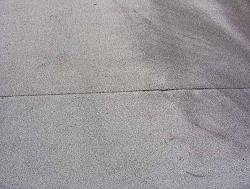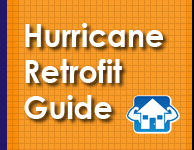|
This section provides guidance for use in evaluating your shingle roof and it includes suggestions for what you can do based on what you find. As you read through the information on roofs, some of the terms used may not be familiar to you. You can click on
Roofing Terms
to access a list of definitions that may be helpful.
Information About Membrane & Built-up Roofs
Membrane or built-up roof covers are most frequently used on roofs that have a very low slope, usually less than about 2-inches of drop for every 12-inches of length. In homes, these low pitch roofs are usually covered with either a membrane that is glued to the roof sheathing or by layers of felt and tar with a gravel placed on top to protect the felt and tar. In most cases, when a membrane is used, it will be covered with a granular surface that looks similar to the surface of asphalt shingles. These granules help to protect the membrane from degradation caused by ultraviolet light from the sun. Low slope roofs are notorious for leaking because the water doesn’t tend to run off as quickly so it has a greater opportunity to work its way through any cracks or splits in the roof cover. Cracks and splits develop over time as the roof cover expands and contracts at a different rate from the contraction and expansion of the deck below.

|
Portion of membrane roof showing seam between membrane sections. The seam is in good shape.
(click image for larger version) |
|
Evaluating Your Membrane or Built-up Roof
If you want to try to evaluate your membrane or built-up roof, you will need to climb up to the roof. If you are not able to make the inspection yourself, get a reputable roofer or home inspector to evaluate your roof. (Check with neighbors and friends for referrals and check with the Better Business Bureau).
Before you go up on your roof to evaluate your membrane or built-up roof, please read about
Ladder Safety Tips.
Then read the text below so that you will have a good idea of what to look for when you get on the roof. Print out the
Membrane or Built-up Roof Inspection Checklist and and have that with you on the roof and in the attic. It will help assure that you remember to check everything on the checklist.
Not only should you check the membrane or built-up roof while up on the roof, you should also check for other potential weaknesses such as loose roof vents.
 If you are not comfortable climbing a ladder to your roof, or your spouse or friends have told you that you have no business on a ladder, you can try binoculars to look over your roof. There are reasons why roofers have extremely high workers compensation rates, so stay off the roof unless you are really comfortable with getting on your roof. If you do climb up read the
Ladder Safety Tips.
If you are not able to make the inspection yourself, get a reputable roofer or home inspector to evaluate your roof.
If you are not comfortable climbing a ladder to your roof, or your spouse or friends have told you that you have no business on a ladder, you can try binoculars to look over your roof. There are reasons why roofers have extremely high workers compensation rates, so stay off the roof unless you are really comfortable with getting on your roof. If you do climb up read the
Ladder Safety Tips.
If you are not able to make the inspection yourself, get a reputable roofer or home inspector to evaluate your roof.
|
From the top of your roof: Look for cracks, holes, gaps, buckling of the roof cover, areas where water doesn’t run off (ponding), and areas where most of the surface granules or gravel cover are missing. These sign of ageing are indicators that your low-slope roof is likely to leak during a hurricane. Check around all pipes, vents or anywhere that something sticks up through the roof membrane. The flashing around these items should be sealed to sides of the item that sticks up through the roof, with no gaps or cracks. Check areas where the low-slope roof connects with any vertical walls or chimneys to make sure that the flashing in these areas is well sealed to the vertical wall. Check the edges of the roof to ensure that the membrane is well anchored around the edges and that any flashing is well attached to the fascia boards. Note if any of the flashing is rusted, torn or damaged. If a membrane roof cover is used, check all joints or seams between pieces of the membrane looking for any blistering, separations, buckling or areas where the layers are not sealed together. Make sure that drainage from the roof is not blocked, clean out any gutters that run along the edge of the low-slope roof.
From inside your attic: Chances are that there is little or no access to the air space under your low slope roof so there is usually little point in trying to peer up into this area.
Inside your house: Look for cracked paint, discolored gypsum board, and peeling wallpaper as signs of damaged roof areas. However, be aware that another cause of stains on a ceiling can come from air conditioning ducts that sweat, i.e. drops of water from condensation that forms on the ducts in a hot humid attic.
Get an Expert Opinion: If you are not able to make the inspection yourself, get a reputable roofer or home inspector to evaluate your roof. (Check with neighbors and friends for referrals and check with the Better Business Bureau)
Retrofit Options
If the inspection and evaluation indicate that the roof needs to be replaced, click on
What to do if you re-roof to read about what your roofer should do to help ensure that you have a hurricane resistant roof. Guidance is provided on that page for specifications you may want to give to the roofers as you get bids for the re-roofing project. The
What to do if you re-roof page also contains a link to a discussion of various roof coverings that may be beneficial if you want to consider different roof cover options. If you are not ready to re-roof, there are still a number of things you can do that will make your roof more hurricane resistant and less prone to water intrusion. Click on
What you can do if you don't re-roof to explore these options. If a hurricane strikes and you do have roof damage, click on
After a Hurricane to get ideas for how to keep damage from escalating.
What to do if you re-roof
What you can do if you don't re-roof
Membrane or Built-up Roof Inspection Checklist
After a Hurricane
Roofing Terms
|

